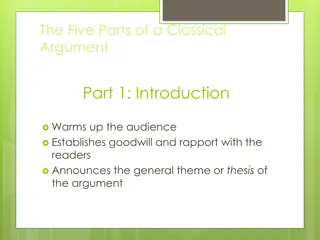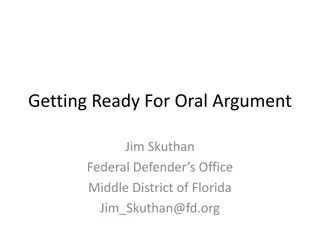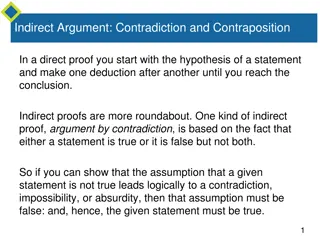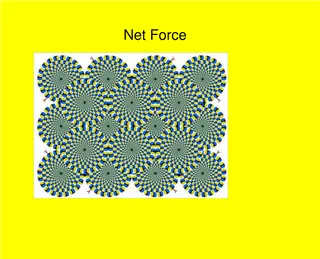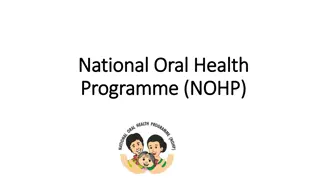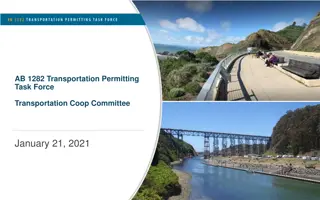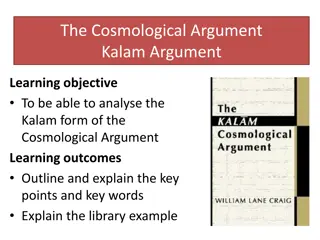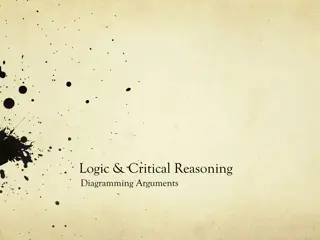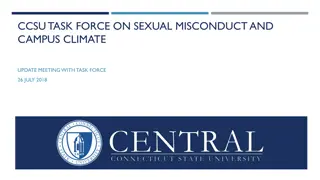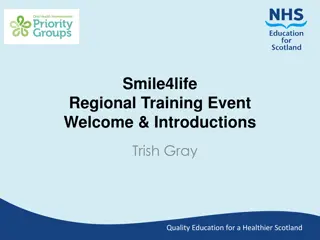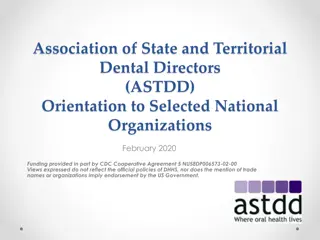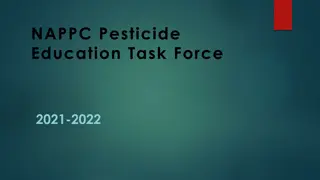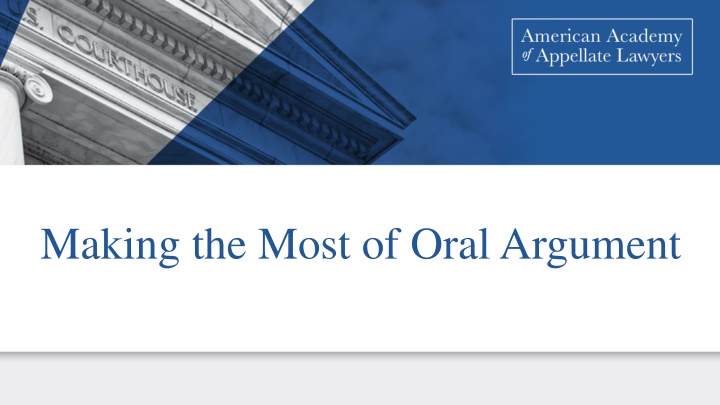
Importance of Oral Argument in Appellate Justice System
Understanding the value of oral argument in appellate courts is crucial for effective advocacy. Oral arguments allow judges to collectively review cases, provide litigants with their day in court, connect citizens to the judicial process, and teach lawyers valuable insights for improved advocacy over time. Chief Justice John G. Roberts Jr. emphasizes the significance of oral argument despite its declining rate. Witness how oral arguments can influence decisions and enhance the transparency and efficiency of the appellate justice system.
Download Presentation

Please find below an Image/Link to download the presentation.
The content on the website is provided AS IS for your information and personal use only. It may not be sold, licensed, or shared on other websites without obtaining consent from the author. If you encounter any issues during the download, it is possible that the publisher has removed the file from their server.
You are allowed to download the files provided on this website for personal or commercial use, subject to the condition that they are used lawfully. All files are the property of their respective owners.
The content on the website is provided AS IS for your information and personal use only. It may not be sold, licensed, or shared on other websites without obtaining consent from the author.
E N D
Presentation Transcript
Oral Argument Remains Important The rate of oral argument has declined significantly over time. Nonetheless, it remains critical. My main conclusion after a year of being on the other side of the bench is that oral argument is terribly, terribly important. Chief Justice John G. Roberts, Jr., Oral Advocacy and the Re-emergence of the Supreme Court Bar, 30 Journal of Supreme Court History 68, 70 (2005).
The Value of Oral Argument Allows the judges to consider the case collectively and allows counsel to explain, face-to-face, the merits of the appeal. Collaborative review (3-judge panel) is more likely than unilateral review (single judge) to produce correct decisions. Oral argument changes the outcome in 10-20% of cases. Judges can t predict which oral arguments are likely to change their minds. During argument, advocates and the other judges can correct misunderstandings and point the panel to the correct result.
The Value of Oral Argument Gives the litigants their day in court. Unlike trial courts, appellate courts mostly operate out of the public eye. Oral argument helps show the parties that the judges are informed and engaged. [J]ustice should not only be done, but should manifestly and undoubtedly be seen to be done. (R v. Sussex Justices, ex parte McCarthy (Lord Hewart, C.J.))
The Value of Oral Argument Connects citizens to the process of appellate justice. Public display of the judicial function advances respect for the rule of law. Live-streaming arguments and making recordings available help the public understand the appellate court s function. Hearing arguments outside the court s seat and in other public places expands public awareness of the appellate process.
The Value of Oral Argument Teaches lawyers how appellate judges approach case resolution, and improves the quality of appellate advocacy over the long term. The judges ask about the issues they have identified as most important, along with the elements of the record and the law most relevant to the resolution of those issues. Lawyers can listen to arguments in other cases to learn how these judges approach oral argument and decision making. Lawyers can see what is effective and ineffective in counsel s interaction with the court.
American Academy of Appellate Lawyers Over 350 experienced appellate lawyers, former judges, and academicians. Mission: The preservation and advancement of justice on appeal. Oral Argument Task Force: Created to study how appellate courts use and manage oral argument. Task Force report and follow-up Federal Court Review promotes professional and public awareness of oral argument s value.
Goals of Preparation To predict judges questions and have persuasive responses at the ready. To create a plan of your affirmative points, so that you can bring the argument back on track after answering questions. To anticipate opponent s arguments, and either address them preemptively or in rebuttal.
Getting Up To Speed Develop a plan for preparation with the appellate and/or trial team. Review the briefs and lower court opinion(s) promptly after receipt of the calendar notice in order to reacquaint yourself with the case. The court will often use the lower court opinion(s) and the reply brief to frame the issues Review authorities cited in the briefs. Prepare notes on important cases, such as which party cited it for what issue, its holding, its procedural posture, and relevant facts. Update case authorities and search for any new authority. Consider whether to submit any new authority to the court prior to argument. Review the full appendix (or other set of key record materials) and identify critical portions for easy reference.
Getting Up To Speed Consider preparing a timeline to keep important dates in mind. Consider preparing a cast of characters to keep relevant names at hand. Track down any loose ends, such as ambiguities, omissions or conflicts in the record and issues that may have arisen from your review of the cases. These loose ends are often the source of questions from the court. Can help to reread the complaint, orders on motions to dismiss or summary judgment, and opening/closing arguments from trial Think about the practical consequences of your position for future cases and other areas of the law Prepare a list of hard questions and proposed answers Discuss the case with nonlawyers, to develop a conversational approach to the case
Planning Your Oral Argument Shine a different light on your points. Although you cannot make new arguments, you can provide the court with a different perspective in order to persuade judges who may not have been persuaded by the briefs. Oral argument time is very limited, so it is unlikely you will be able to address all of the issues in the briefs. Consider what points you want to make. If you have 15 minutes, try to plan a core argument of 10 minutes. Consider what issues to expect from both your opponent and the court. Where are your weak points? How can you lose? Identify the 3 most important points you want the court to focus on. You will pivot back to them whenever you finish answering a question, and likely work them into your answers.
Oral Argument Notes Oral argument notes reflect the advocate s own preferences. Some write out remarks in full. While you should not read your argument, writing it out can create ready remarks on a number of topics. Some write only an opening, with the rest in bullet form. Some prefer no notes at all, though that risks not having key information to hand. Include relevant facts, dates, and names, with references to the record. Include key language from contracts, statutes, regulations, and cases. Including the precise language makes it possible to quote verbatim if appropriate. You will want all of this information at your fingertips. Searching through the briefs, record, or cases to answer a question wastes precious argument time.
Oral Argument Notes Be prepared to state the rule of law that will result in a judgment in your favor. Be prepared to state the specific result you are requesting (affirmance, reversal, vacatur, directing entry of judgment, remand for reconsideration of some or all issues, new trial on some or all issues, etc.). Anticipate questions about your case and other hypothetical scenarios, and craft answers to those questions. Being able to answer hypothetical questions is critical. Hypotheticals are how judges test and understand the effect of your proposed rule.
Moot CourtsA Best Practice No preparation for oral argument is as valuable as a moot court in which you re interrogated by lawyers as familiar with your case as the court is likely to be. Nothing, absolutely nothing, is so effective in bringing to your attention issues that have not occurred to you and in revealing flaws in your responses you have been aware of. Antonin Scalia & Bryan Garner, Making Your Case: The Art of Persuading Judges 158 (2008). Oral advocacy is an art. But similar to the art of hitting a baseball, it requires extensive practice and some idea of what the pitcher is about to throw. [M]oot courts are a best practice for even the most experienced appellate lawyer. Timothy Lewis & Nancy Winkelman, The Benefits of Moot Courts: Perspectives of an Arguing Attorney and a Judge, For the Defense 44, 45, 48 (Nov. 2010).
Why Have a Moot Court? To sharpen and refine the arguments made in the briefing To get a feel for how particular arguments sound and are received To practice responding to questions without getting sidetracked A good moot court provides answers to the following questions: What are the judges likely to ask? What may the judges ask that the parties have not even thought of? What arguments are likely to make the most headway? How best to address problems in the case? Has the advocate succumbed to tunnel vision?
The Moot Panel Assemble a moot panel that approximates the real judicial panel. The real panel won t have advance knowledge of the case; neither should the mooters. The real panel will learn the case from briefs, cited legal authorities, the order under review, and (perhaps) parts of the record. Moot panel should prepare as if they were the real panel. Moot panel should include members who are experienced in appeals, such as appellate attorneys, former appellate judges, or former law clerks from the relevant court. Can be useful to have at least one mooter who has the time and energy to dig in to the record
Types of Practice Sessions There is no single correct moot format; the goal is to help the advocate prepare. Common options: Formal moot, with advocate presenting argument as though in the appellate court. Informal roundtable, with question-and-answer session and discussion of issues. In some moots, a team member argues as opposing counsel. This can provide deeper insight into the other side s strongest positions. In an appellant-side moot, having someone play the appellee allows for practicing rebuttal. However, it requires more resources, as someone needs to learn and prepare argument for the opposition. It can be more efficient to have that person simply act as a member of the moot panel.
The Formal Moot A Popular Choice Possible elements of a formal moot: Advocate gives prepared argument (or opening statement) without interruption. Allows neutral evaluation of whether the advocate is starting on the right foot. Some advocates skip this step, especially when arguing for the appellee, since the appellee s opening can vary widely depending on how the judges questioned the appellant. Advocate gives argument and practice panel interrupts with questions. If a line of questioning proves challenging, don t hesitate to go out of role and ask for the panel s suggestions on how to deal with it. If someone is playing role of opposing counsel, that person argues in this phase.
The Formal Moot A Popular Choice If possible, have someone take notes so advocate can implement comments afterwards. Nerves and adrenaline often mean the advocate won t clearly remember everything that happens in a moot Some advocates record their moots. After questions have been exhausted, sit down and have a post-mortem. Ask each mooter individually to comment on what worked, what didn t, what could be improved. Mooters won t always agree, which is also useful judges have different perspectives too.
The Informal Roundtable In a roundtable, the advocate convenes the judges and co-counsel for practice question-and-answer sessions. . . . [T]he floor remains open for brainstorming about the best answers. Some advocates hold such a brainstorming session early in their preparation, after which they . . . hold a more formal moot court. There is no one-size-fits-all formula. Mayer Brown LLP, Federal Appellate Practice 485-86 (2d ed. 2013).
Timing Some advocates prefer to do a formal moot, or their last roundtable, on the eve of the real argument. More commonly, the moot is held a few days ahead or even earlier. This allows the advocate time to absorb and follow up on points raised at the moot. In substantial matters, the advocate may schedule more than one moot. Leaving time between moot and actual argument permits the advocate to run retooled ideas by the moot court judges.
Logistics Technology allows for different moot configurations: Traditionally, all participants attend in one room. Videoconferencing allows participants to attend remotely, which saves travel costs. Ensure that all participants can hear and speak simultaneously. Some advocates like to keep time in order to see how much material fits into the allotted oral argument time. However, the moot frequently goes well over the allotted time 15 minutes go by very quickly in an active moot. Goal is to harvest questions and to try out answers, so more time should be budgeted than for real argument. A good formal moot in a multi-issue case often lasts over an hour, even before the post-mortem discussion begins.
Cost For hourly cases, the fee for the added moot judges time is the main added cost. The advocate and the appellate team will prepare for the real oral argument in any event. For cost sensitive cases, reduce the number of moot judges. For non-hourly cases: Public agencies often ask other agency attorneys to serve as moot panelists. In contingency fee cases and criminal defense cases, counsel may participate in each other s cases as a courtesy. Moot panelists often serve at no charge for pro bono cases. Some law schools and public interest organizations offer free moot courts.
Delivery of Oral Argument Knowing the Venue What to Take to Court What to Take to the Lectern Dealing With Interruption Hostile Questions and Traps Humor The Red Light Rebuttal Post-argument Submissions
Knowing the Venue Determine courthouse logistics. How long do you need to clear security? Are laptops/tablets/phones allowed in the building, or best left at the office? Identify comfortable places to sit (lawyer s lounge, library, cafeteria, etc.). Identify visual/oral distractions (beautiful artwork, squeaky chairs, loud HVAC systems, etc.) so they aren t a surprise on the day. Listen to (or if possible, attend) other arguments in the venue. Determine mechanics of argument. What is the setup at the lectern? Is counsel table within easy reach to grab a brief or appendix? How well do voices carry or do judges hear? Are there any local customs or procedures you didn t anticipate? Are arguments televised/livestreamed? The camera can see you even when you re sitting at counsel table or in the public gallery.
Knowing the Audience Determine the panel members, if possible What is their questioning style? Have they encountered this subject matter before? Did they sit on / author any key decisions? Listen to (or if possible, attend) other arguments of theirs. Know the judges names and how to pronounce them. If in doubt, ask the Clerk. Otherwise, simply say Your Honor.
Minimize Distractions on the Day Prepare physically and psychologically. Oral argument is not the time to vary your wellness routine. Maintain usual habits that make you feel strong and confident (exercise, meditation, etc.). If you regularly drink caffeine, don t forget to have it on argument day. If you have rituals or superstitions about argument, make the time to fit them in. Have a good breakfast you need fuel both to wait for your case to be called, and then to go straight into an extreme performance event. Ensure you are comfortably dressed. Account for temperature and weather. Wear shoes you can stand in for an hour.
Courthouse Necessities Is there water at counsel table, or do you need to bring it with you? Find facilities near the courtroom. Quiet place for final preparation/consultation before court is called. Instructions for client, co-counsel on how to find the courtroom, and how to interact with you during/after the session. Assume that judges hear everything said in the courtroom, even when court is out of session. Assume that law clerks and staff will hear and report anything said in the hallways.
What to Take to Court Reread the briefs and lower court opinion 1-2 days before the argument; you may spot things that you didn t when you were just getting up to speed. Have your whole file with you, because you never know where a question will go, what your opponent will raise, or what you will want to consult. All briefs Appellate appendix / record (even if voluminous) Copies of cases / authorities Organize your material so that you can easily locate everything.
The Second Chair Ideally someone extremely familiar with the record, who could help you find something quickly if need be. Ultimately, situations where you really need help finding something or considering an unanticipated question should be rare NOT someone who will constantly whisper in your ear or pass you multiple notes Resist the urge to overlawyer, especially when representing a large company or a rich defendant. Appearing alone can be effective.
What to Take to the Lectern A notebook or a binder, not multiple loose pages. Turning pages in a notebook appears more professional than flipping pages of a legal pad. (Guide for Counsel in Cases to be Argued Before the Supreme Court of the United States) Don t read unless you need to quote something verbatim. If you need to refer to a brief, appendix, or case, it s acceptable to reach to counsel table to get it but don t speak while you re away from the microphone. OK to sip water while being asked a question, but maintain eye contact. Pens are usually distracting; if you must have one, put it down while arguing and use it only to write. Some advocates argue from a tablet, rather than paper notes. Can be effective with a big record, but make sure you know your technology.
Demonstratives Demonstratives, chalks, and slides are unusual in appellate practice, as they distract the court from the content of the advocate s presentation. Occasionally useful to show the court a physical exhibit (e.g. accused product or device), but ensure that it is actually part of the record on appeal. Determine whether advance leave of court is needed for demonstratives. If you use a demonstrative, make sure the judges can see it. Some state appellate courts (e.g. Texas) use Bench Books, which contain 4-5 items that counsel wants to be sure the court looks at (key exhibit, contractual term, statutory language, jury charge excerpts, etc.). Other jurisdictions allow an addendum to the appeal brief. It can be effective to refer to a particular page of a brief, addendum, or appendix for material of particular relevance.
Delivery Oral argument is in some ways a misnomer: discussion or conversation are better. Under no circumstances should you read your argument from a prepared script. You should speak in a clear, distinct manner, and try to avoid a monotone delivery. Guide for Counsel in Cases to be Argued Before the Supreme Court of the United States II.3). [CLIP REMOVED]
Sharing Argument Time Sharing argument time almost always weakens the presentation Interrupts flow, makes it difficult to switch from one topic to another Raises risk of inconsistent positions Sharing time can sometimes be avoided by inviting the co-parties to your moot and showing them that you will fully protect their interests as well If sharing is absolutely necessary, try to separate out subject matter so that the first advocate doesn t wind up addressing all issues If the first advocate goes over allotted time, some courts will allow the subsequent advocates their full time. But many courts view it as counsel s responsibility to manage time, with the result that the subsequent advocates will simply lose out.
Interruption Questions or comments from the bench should be welcomed; they reveal the court s thoughts and concerns, which you can then address directly. Never interrupt a Justice who is addressing you. (Supreme Court Guide for Counsel) Don t assume that you know where the question is going. If you are speaking and a Justice interrupts you, cease talking immediately and listen. (Supreme Court Guide for Counsel) Returning ( pivoting back ) to your argument thread is probably the appellate advocate s most important skill. [CLIP REMOVED]
Hostile Questions Engage with hostile or skeptical questions, but answer them on your terms. Do not accept hidden assumptions or loose terminology in a question. Conceding points that don t matter can be very effective, but don t do it accidentally. If a judge says you conceded something you did not mean to concede, say It was not my intent to concede that point, because ___. Don t be bullied; be polite and deferential, but stand firm.
Humor Attempts at humor usually fall flat. (Supreme Court Guide for Counsel) Planned jokes are especially ill-advised. Humor only works if it s at your expense.
The Red Light A prepared ending to the argument is often useful. Appellant s opening argument: Remember to reserve rebuttal time. Ending is important for Appellee and critical for Appellant s rebuttal. Be ready to pivot from an answer to a question into your final word. If all else fails, state your desired disposition and relief sought. ( We respectfully submit that the judgment should be affirmed/reversed/remanded for a retrial/etc. ). You don t need to use all your time! Body language often reveals when the judges are done. If you can tell that you have answered all questions, ending early can be very effective.
Rebuttal Not all appellate courts allow it make sure you know ahead of time whether you will get it, and if you need to reserve it ahead of time. Not a time to recap your entire case; make targeted responses that arose in questioning or that your opponent made. It can be very effective to answer a question your opponent couldn t. Point out what points the appellee left uncontested. Correct errors by the other side, especially regarding the state of the record. Many judges won t interrupt rebuttal with questions, but if a question comes, drop everything and answer.
Post-Argument Submissions It s not over after the argument. Monitor further developments in the law that might affect your case (new decisions, statutes, regulations, important developments in related cases). Most courts have a procedure permitting short post-argument submissions (e.g. Fed. R. App. P. 28(j)). If a longer submission is needed, consider a motion for leave to file a supplemental brief. Often the proposed supplemental brief is tendered at the same time, but local practices vary.
Questions? Mark.Fleming@wilmerhale.com

